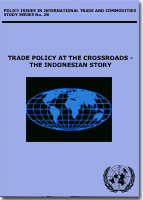
Following the crises of the late 1990s and the subsequent slowdown in the world economy, many countries in the developed and developing world are at the crossroads in their trade strategy, uncertain whether to advance with trade reforms, to stand still or increase protection. While the case for liberalization has been widely accepted as a long-term goal for economic policy, the gains from trade have not always been forthcoming and macroeconomic crises have exacerbated the situation. The delayed and uncertain benefits of reform, plus the costs of adjustment, the need to offset tariff revenue losses, and the possible benefits of some degree of intervention to foster industrialization have all contributed to this indecision. Support for the WTO multilateral negotiations now appears half-hearted, and there are calls for increased protection. Following the slow progress of multilateral negotiations, attention has inevitably turned to regional and bilateral agreements.
Indonesia provides an interesting case study of the potential benefits and costs of alternative trade strategies that are under active consideration in many developing countries. The ASEAN region has recently announced a deepening of its commitments and is considering widening the agreement to include countries such as China, Japan and the Republic of Korea. A bilateral agreement with the United States is also a possibility. Against this background, Indonesia´s options on trade policy range from increasing protection to actively pursuing bilateral, regional and multilateral initiatives.
The results of a global general equilibrium analysis point to several interesting implications for policy makers. The results from the model show that increasing protection results in economic losses while a stand still and more liberalization produces economic gains. After undergoing full adjustment, estimated annual gains to Indonesia from a conservative Uruguay Round-style outcome within the WTO system total an estimated $380 million (0.22 per cent of GDP). However, annual gains from a completely liberalized ASEAN plus China, Japan and Republic of Korea regional trade agreement are estimated at $2.3 billion, again after adjustment. Indonesia could capture half of these benefits by liberalizing unilaterally. The major source of the gains from unilateral, regional and multilateral liberalization is improved efficiency following removal of tariffs on politically sensitive sectors such as motor vehicles. This improves productivity in many downstream sectors. There are significant trade diversion effects from regional integration, with non-members worse off as a result. The results have implications for other countries having second thoughts about their strategy.



